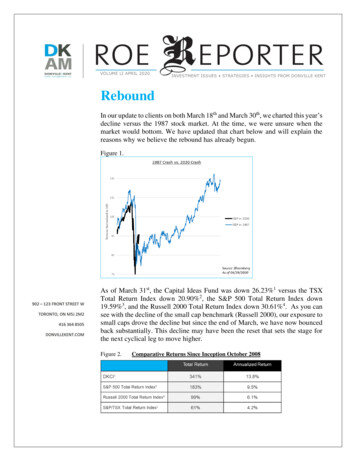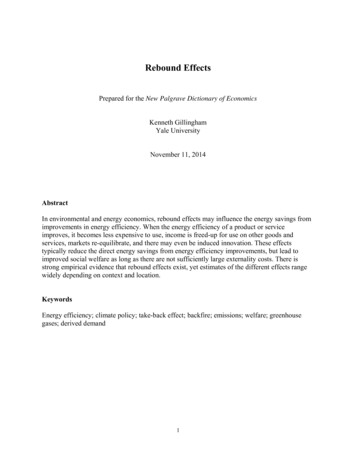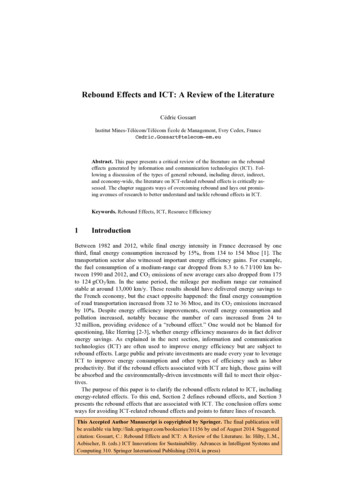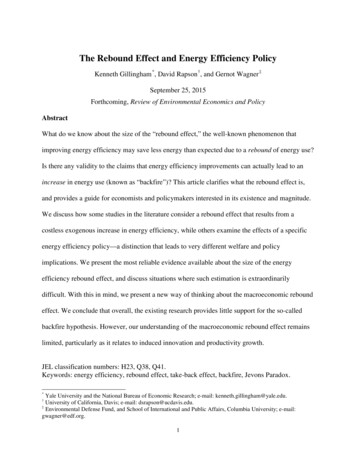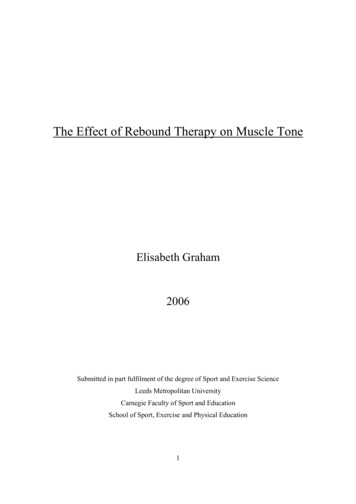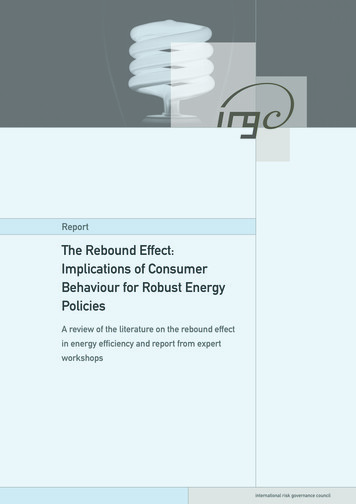
Transcription
P1ReportThe Rebound Effect:Implications of ConsumerBehaviour for Robust EnergyPoliciesA review of the literature on the rebound effectin energy efficiency and report from expertworkshopsImplications of Consumer Behaviour for Robust Energy Policiesinternational risk governance council
P2Abbreviations used in the text:ACEEEAmerican Council for an Energy-Efficient EconomyAEOAnnual Energy OutlookAESactual energy savingsAIDSalmost ideal demand systemCEDMCenter for Climate and Energy Decision MakingCESconstant elasticity of substitutionCGEcomputable general equilibriumCMUCarnegie Mellon UniversityGDPgross domestic productGHGgreenhouse gasEIAEnergy Information Administration (USA)EUEuropean UnionIEAInternational Energy AgencyIOinput-outputIRGCInternational Risk Governance CouncilLCAlife cycle assessmentNASNational Academy of Sciences (USA)NRCNational Research Council (USA)OECDOrganisation for Economic Co-operation and DevelopmentPESpotential energy savingsSUVsport utility vehicleUBCUniversity of British ColumbiaCover: photograph AZAdam/Flickr All rights reserved, International Risk Governance Council, Lausanne, 2013Reproduction of original IRGC material is authorised, provided that IRGC isacknowledged as the source.ISBN 978-2-9700772-4-4international risk governance councilThe Rebound Effect
P3ContentsPreface4Executive summary51 Why do we care about characterising potentially unanticipated impactsfrom investments in energy efficiency?72 Defining the consumer responses to changes in efficiency93 Drivers of consumer responses to changes in energy efficiency and energy prices124 Previous studies of “direct rebound effect”154.1 Residential sector154.2 Mobility sector164.3 Industrial and commercial sectors165 Uncertainties in the estimates of indirect and economy-wide rebound effects176 Rebound effects in developing countries and economies in transition207 The integration of rebound effects in energy scenarios and models228 Do drivers for energy efficiency affect rebound effects?229 Policy implications2310 Research roadmap24Appendix 126“Think pieces”/presentations for the first “Energy Efficiency and the Rebound EffectWorkshop”, AAAS Building, Washington, DC, 27–28 June 2011Appendix 228“Think pieces”/presentations for the second “Energy Efficiency Policies and the ReboundEffect Workshop”, Kongresshotel Europe, Stuttgart, 13–14 October 2011References29Acknowledgements33About IRGC34Tables and figuresFiguresFigure 1: Economy-wide rebound estimates vary by country19TablesTable 1:Table 2:Ranges of estimates for direct rebound effects from previous studies15Estimates of price and income elasticity for energy in developing countries andeconomies in transition from previous studies (adapted from Lee and Lee, 2010)21Implications of Consumer Behaviour for Robust Energy Policiesinternational risk governance council
P4PrefaceThe International Risk Governance Council (IRGC) is a non-profit and independent foundation whose purpose is tohelp improve the understanding and governance of systemic risks that have impacts on human health and safety, theenvironment, the economy and society at large.In 2011 IRGC, the Center for Climate and Energy Decision Making (CEDM) at Carnegie Mellon University (USA) and theInterdisciplinary Research Unit on Risk Governance and Sustainable Technology Development (ZIRN) at the University ofStuttgart (Germany), in collaboration with the School of Public Policy and Management at Tsinghua University (China) andthe University of British Columbia (UBC, Canada)1, organised two workshops on the topic of “Energy Efficiency Policiesand the Rebound Effect”. Support for these efforts came from CEDM2, IRGC, UBC and the University of Stuttgart.The first workshop was held in Washington, DC, USA on 27–28 June 2011 and led by CEDM. The second was held inStuttgart, Germany on 13–14 October 2011 and led by Dialogik gGmbH and the University of Stuttgart.Participants were invited “to identify and develop research needs in respect to different approaches to measuring directand indirect rebound effects that may arise from investments in, and policies regarding, energy efficiency”. Prior to theworkshops, investigators at the Center for Climate and Energy Decision Making and at the University of Stuttgart performedliterature reviews that identified a very mixed and diverse set of findings in terms of the magnitude and importance ofrebound effects across end-uses, time periods covered and regions or countries studied. The goal of the workshops wasneither to provide a consensus on the magnitude of the rebound effect nor to perform new research. Rather it was to clarifyconfusion in the taxonomy, to identify the gaps in existing research and to identify future research needs.We include on page 33 a list of the experts who participated in each workshop. In preparation for each of the workshops,all participants were asked to prepare a three-page “think piece” and a short presentation addressing a specific set ofquestions posed. The specific links to these “think pieces” can be found in Appendices 1 and 2, and the whole set canbe found at: http://cedm.epp.cmu.edu/rebound.php. We cite several of these “think pieces” throughout this report.Comments are especially welcome on how IRGC’s focus on energy efficiency and the rebound effect could make aconstructive contribution. More information on the project can be obtained from info@irgc.org.1University of British Columbia support comes from funding from the Pacific Institute for Climate Solutions.2CEDM support comes from a cooperative agreement (SES-0949710) between Carnegie Mellon University and the National Science Foundation of the USA.international risk governance councilThe Rebound Effect
P5Executive summaryThe direct and indirect rebound effect can be related to two familiareconomic effects:Substitution effect: Efficiency gains in a particular energy servicelead to a shift into more consumption of that service and out ofIn recent years, energy efficiency policies have been deployed orother goods and services; andsuggested across the world, as part of countries’ energy policiesand/or as a way to achieve climate change mitigation goals. DriversIncome effect: Efficiency gains in a particular energy service makefor the promotion of energy efficiency policies include a desireavailable additional income from energy cost savings which canto reduce energy consumption and in particular dependence onbe used for greater consumption overall, in both energy and otherforeign fuel supply, to lower greenhouse gas (GHG) emissions ingoods and services.order to mitigate the impacts of climate change, to reduce criteriaair pollutants, and to provide affordable energy services. While it isChanges in consumption patterns: Substitution and incomewidely acknowledged that there is still a large potential for energyeffects may lead to overall changes in consumption patterns. Forand greenhouse gas savings, the design of effective policies toexample, energy efficiency gains lead to changes in behaviourrealise that potential is challenging.(such as buying more frozen food when energy efficient freezersare available). Measurements of the direct and indirect reboundAs consumers pursue cost-effective energy efficiency investments,effect would also include these changes in consumption patterns.they will have economic savings over the lifetime of theirinvestment. Questions about how these economic savings areEconomy-wide rebound effect: Energy efficiency investmentsused by the consumers have led to a long debate in the energylead to changes in the prices of goods and services, which lead toeconomics and energy policy literature on whether some of thestructural changes in the economy, resulting in a new equilibriumtheoretically estimated gain in energy efficiency will be eroded asin the consumption of energy and other goods and services.consumers consume additional goods and services. In this report,we summarise the findings from two workshops on the topic ofWithout first sorting and classifying studies in terms of these“Energy Efficiency Policies and the Rebound Effect”.different mechanisms, it is not easy to compare study results ordetermine when and whether rebound effects are large or small.There has been considerable confusion about nomenclaturewith respect to the rebound effect. To clarify the discussion, weHaving clarified these differences, the report then reviews availableadopted a taxonomy for consumer responses to changes in end-literature. Direct rebound effects estimates for the residential sectoruse efficiency for an energy service. These include:are found to range from zero to 60 per cent depending on the enduse, the method used to estimate the rebound effect, the periodDirect rebound effect: Efficiencyof analysis and the geographical area under study. In the transportgains lead to a lower cost of energysector, studies on rebound effects report ranges from 4–87 perservices, leading to an expandedcent. Rebound effects in the commercial and industrial sectors,or intensified use of the energyand indirect and economy-wide effects for all sectors, have beenconsuming product/service. Forthe focus of much less research, and there is a large uncertaintyexample, when consumers switchabout the magnitude of these effects.from incandescent light bulbs tocompact fluorescents, they mayThere is very little evidence of direct or indirect rebound effectsleave their lights on for more hours than they did previouslyexceeding 100 per cent (so called “backfire”) for household energybecause of lower lighting operation costs;efficiency investments in developed countries.Indirect rebound effect: The additional income that is freed upThis report does not intend to present a full comprehensiveby saving energy costs can be used for other energy- or carbon-analysis of the rebound effect. There are other drivers for consumerintensive consumption. For example, the income gained byresponses that might be important to understand consumerinstalling an efficient furnace and insulating one’s house could bebehaviour and that are included neither in the taxonomy abovebundled into additional air travel, leading to an overall increasenor in this report, beyond emphasising their probable importance,in GHG emissions.and/or recommending that a research agenda on these topics isdeveloped. These include, but are not limited to, perceptions ofprices, prestige and status effects, attitudes and values, lack ofImplications of Consumer Behaviour for Robust Energy Policiesinternational risk governance council
P6knowledge in the application of energy efficient devices, lifestyles,moral licensing and personal norms, habits, time and needssatiation.Rebound effects could be large in the developing world, amonglow-income groups, and in the production sector of the economy.There has been far too little study of these groups. Such researchis needed to gain a better understanding of the magnitude ofrebound and the extent to which such rebound effects lead toenhanced individual well-being and desirable socio-economic ormacroeconomic co-benefits.Many countries have ambitious energy policies goals and targets.Care should be taken to insure that energy efficiency policies arenot called into question in general, as the existing studies suggestthat energy savings are achieved. Energy efficiency policies couldbe improved by explicitly taking into account rebound effects,both in programme design and also in the energy scenarios andmodels that support policy decision-making. If policymakersare concerned with the environmental and health externalitiesassociated with rebound effects, taxes or cap and trade policieswould assure that the negative externalities from rebound effects– and energy demand in general – are accounted for.Given the growing emphasis that decision-makers are placing onpromoting energy efficiency as a strategy to deal with growingenergy demand and costs, limited energy supplies and greenhousegas emissions, it is critically important to develop a betterunderstanding of the nature, determinants and magnitude of thedrivers of energy demand.international risk governance councilThe Rebound Effect
P71 Why do we care aboutcharacterising potentiallyunanticipated impactsfrom investments in energyefficiency?acknowledged that the residential sector holds the potential forenergy and greenhouse gas savings, the design of effective policiesto realise that potential is challenging. Ehrhardt-Martinez andLaitner (2010a) suggest that “people-oriented” strategies (i.e.,strategies that focus on behaviour related energy savings) couldreduce energy consumption in the residential sector by up to 25per cent.Policymakers list a variety of objectives when implementing energyefficiency policies and measures in the buildings and transportationsectors. These include: reducing energy consumption; reducingAcross the world countries have been adopting energy efficiencygreenhouse emissions; reducing consumers’ energy bills; andpolicies over recent years in efforts to lower reliance on foreignmoving toward a more sustainable energy system than thatfuel supplies, reduce greenhouse gas emissions and air pollution,provided by “business as usual”.mitigate climate change and make energy supplies more affordable.In order to know whether such goals will actually be met, and toIn the United States, energy efficiency standards for several end-pursue energy efficient strategies that are both smart and wiseuses and technologies have been fostered under revisions of theconcerning the different policy goals mentioned above, a startingEnergy Policy Act of 2005 and under the Energy Independence andpoint is to understand the technological and economic potential forSecurity Act of 2007. The American Recovery and Reinvestmentenergy/carbon dioxide savings from energy efficiency measures.Act of 2009 included a budget of roughly US 17 billion allocatedSeveral studies have addressed this issue (see for example, NRC,to energy efficiency investments (ACEEE, 2011). In March 2011,2010; Azevedo, 2009; Azevedo et al., 2013; Ürge-Vorsatz et al.,the European Union pledged a reduction in primary energy2009; Brown, 1993; Rubin et al., 1992; McKinsey, 2007; Brown etconsumption of 20 per cent by 2020, using 2006 as a baselineal., 1998; Nadel et al., 2004; Meier; 1982; Blumstein et al., 1995;year (EU Commission, 2011). In China, the 12th five-year energyRosenfeld et al., 1991; Rosenfeld et al., 1993; Koomey et al., 1991;development plan for the period from 2011 to 2015, aims to achieveOTA, 1991).a 16 per cent reduction in energy consumption per unit of grossdomestic product (GDP) and a 17 per cent reduction in carbonHowever, grounding policies based solely on technological/dioxide emissions per unit of GDP by 2015 compared with 2010economic potential may be a mistake: adoption of new energy(Pew Center on Global Climate Change, 2011). A summary of theefficiency technologies requires consumer acceptance, and thusrecent policies deployed by several countries, with the objectivethe other aspect of relevance to policymakers, as they designof improving efficiency by which energy is used, can be foundenergy efficiency policies, is to understand how consumer decision-in the International Energy Agency’s (IEA) report for the Energymaking and behaviour affect efficiency investments, consideringEfficiency Working Party (IEA, 2010; IEA, 2011).changes in economic incentives (Bohi and Zimmerman, 1984;Dahl and Sterner, 1991; Hanly et al., 2002; Espey and Espey, 2004;Policy goals to foster energy efficiency generally assume thatReiss and White, 2005; Frondel et al., 2008, 2010; Madlener et al.,there is a subset of energy efficiency measures that would be2011; Greene, 2011), and social as well as psychological processescost-effective for consumers. For example, in the USA, the(Attari et al., 2010; Ehrhardt-Martinez and Laitner, 2010a; Gardnerresidential sector accounts for 37 per cent of national electricityand Stern, 1996; Stern, 1992; Wilhite and Lutzenhiser, 1999;consumption, 17 per cent of greenhouse gas emissions and 22Lutzenhiser et al., 2001; Lutzenhiser, 1993). It could then beper of primary energy consumption . Using a bottom-up model,possible to predict how the net effect of these factors will influenceAzevedo et al. (2009) estimated that nearly 30 per cent of USAthe overall amount of energy used.3,4residential carbon dioxide emissions could be avoided with energyefficiency strategies that provide the same level of energy servicesIn this report, we focus on a subset of the above mentionedand are cost-effective for residential consumers. While it is widelyconsumer behaviour related issues – if consumers pursue cost-3Using 2008 AEO detailed tables, Table 10 – Energy Consumption by Sector and Source, US Energy Information Administration (EIA).4Using EIA GHG flow from 2006. EIA reports that the residential sector is responsible for 1,234 million metric tons of carbon dioxide equivalent, and that totalgreenhouse gas emissions in the United States are 7,076 million metric tons of carbon dioxide equivalent.Implications of Consumer Behaviour for Robust Energy Policiesinternational risk governance council
P8effective energy efficiency investments, they will have economicsavings over the lifetime of their investment. The issue of how theseeconomic savings are used by consumers has led to a long debatein the energy economics and energy policy literature on whethersome of the theoretically estimated gain in energy efficiency willbe eroded as consumers consume additional goods and services.The purchase of a more fuel-efficient car may lead to a morefrequent use of the car, as the driving cost per mile decreases.The result may be less energy saving than if the use patterns hadremained unchanged. Similarly, more efficient appliances mayprovide greater capacity or be used more intensely. Consumersmay re-spend the economic savings on other energy or non-energyservices. Finally, if such changes in consumers’ consumptionpatterns occur, producers are likely to adjust their productionfunctions with the result that the overall structure of the economymay change. While we describe this effect using consumers asan example and focus mainly on household behaviour throughoutthe report, a similar logic applies to gains in energy efficiencyexperienced by producers.international risk governance councilThe Rebound Effect
P92 Defining the consumerresponses to changes inefficiency1. Direct rebound effect: Efficiency gains lead to a lower price ofenergy services, leading to an expanded or intensified use of theenergy consuming product/service. For example, when consumersswitch from incandescent light bulbs to compact fluorescents,they may leave them on for more hours than they did previouslybecause their operation costs less.2. Indirect rebound effect: The additional income that is freedResearch in energyup by saving energy costs can be used for other energy- orefficiency suggestscarbon-intensive consumption. For example, the income gainedthat there is an energyby installing an efficient furnace and insulating one’s house couldefficiency gap, i.e., a gapbe bundled into additional air travel, leading to an overall increasebetween current energyin GHG emissions.consumption levels andthe potential optimalThe direct and indirect rebound effect can be related to two familiarlevels of consumptioneconomic effects:assuming the adoption of the cost effective and efficient end-usetechnologies that would provide the same level of energy servicesSubstitution effect: Efficiency gains in a particular energy service(Hirst and Brown, 1990; Jaffe and Stavins, 1994). Many scholarslead to a shift into more consumption of that service and out ofhave described qualitatively the reasons why such a gap existsother goods and services.(Anderson and Claxton, 1982; Golove and Eto, 1996; Brown, 2001,Blumstein, Krieg et al., 1980), categorising the reasons as marketIncome effect: Efficiency gains in a particular energy service makefailures and barriers to the adoption of efficient technologies.available additional income from energy cost savings which canMarket failures are flaws in the market operation that make currentbe used for greater consumption overall, in both energy and otherconsumption levels deviate from the social optimum. They include,goods and services.for example, the fact that environmental and other externalitiesare not included in energy prices; the existence of distortionalAfter accounting for substitution and income effects, the directregulations such as subsidies for particular technologies or fuels;rebound effect focuses on net changes in energy serviceimperfect information; and split incentives. Barriers to energyconsumption, while the indirect rebound effect focuses on theefficient technology adoption are factors that lead to choicesnet changes in other goods or service consumption.of energy inefficient technologies by consumers. These barriersinclude issues such as uncertainty regarding the future price of3. Changes in consumption patterns: Substitution and incomeelectricity or other fuels, lack of access to financing for energyeffects may lead to overall changes in consumption patterns. Forefficiency measures and the fact that energy efficiency often isexample, energy efficiency gains lead to changes in behaviourinseparable from other unwanted features in products (Golove(such as buying more frozen food when energy efficient freezersand Eto, 1996). However, while all these issues are very relevantare available). Measurements of the direct and indirect reboundfor consumer behaviour and energy consumption, our reporteffect would also include these changes in consumption patterns.does not attempt to address the issue of the energy efficiencygap. Instead, we start with the premise that an improvement in4. Economy-wide rebound effect: Energy efficiency investmentsenergy efficiency occurs and discuss the energy consequenceslead to changes in prices of goods and services, which lead toassociated with consumer behaviour. Recent and current literaturestructural changes in the economy, resulting in a new equilibriumon energy efficiency and energy efficiency “rebound” often lumpsin the consumption of energy and other goods and services.quite different consumer behaviours under the general term of“rebound”.Without first sorting and classifying studies in terms of thesedifferent mechanisms, it is not easy to compare study results orRecent reviews (Sorrell, 2007; Turner, 2009; Jenkins et al., 2011) ofdetermine when and whether rebound effects are large or small.prior work have helped to untangle the definitions and estimatesof each of these effects, but much confusion remains with respectThe classical economic explanation of the Jevons Paradoxto the taxonomy of mechanisms and the ranges of the estimates(Jevons, 1865) is that improvements in technology reduce theassociated with these different “rebound effects”. Here we usethe following definitions:Implications of Consumer Behaviour for Robust Energy Policiesinternational risk governance council
P 10price of providing such services, therefore increasing demand forHowever, some authors have questioned the validity of Brookes’those or other energy-intensive services, and eroding the gainsand Saunders’ formulations, given that such models are highlyin energy and carbon dioxide reductions from efficiency. Jevonsstylised and entail limited or no empirical evidence. In addition,explored this issue in the context of the use of coal, looking at theBrookes’ price-induced energy substitution describes a broaderincreasing efficiency of conversion from coal to work in Englandsituation than the increase in energy service demand describedin the 19th century. While there are many historical examples,by Khazzoom. The distinction between consumers’ behaviouralit seems likely that this effect actually arises from a number ofresponses to changes in energy prices versus changes in theinteractions between behavioural, economic and technical factorsenergy efficiency of technologies was lost in Brookes’ arguments.– and disagreements about the size of this effect are perhapsHowarth (1997) has shown that given the distinction betweenderived from the fact that researchers use different definitions andphysical energy and energy services, and given an assumptionboundaries of analysis to estimate this effect.that the production of energy services from physical energyoccurs by means of the Leontief production function, Brookes’The revival of attention to the issue of “rebound” emerged in thefindings do not hold. Saunders (2000) shows that, using Cobb-late 1970s with Brookes (1979), followed by Khazzoom (1980).Douglas production functions, fuel consumption increases withHowever, instead of looking at the technological change inefficiency investments. However, Saunders (2008) shows that byproductive sectors, Khazzoom (1980) explored a very differenttheir structure Cobb-Douglas functions always predict backfire.issue: the impact of energy efficiency standards for householdAccordingly, other authors (Sorrell, 2007; Sorrell et al., 2008) haveappliances. Khazzoom discussed the difference between therenewed the call for the study of rebound effects from an energytechnical potential of energy efficiency and what in fact could beservices perspective.expected to happen given an elasticity of energy demand withrespect to appliance efficiency, which under certain assumptionsBinswanger (2001), starting with the same formulation as Khazoomis equivalent to the elasticity of energy demand with respect to(1980), provides the derivation for the rebound effect for a singleenergy prices. In his seminal paper, Khazzoom also noticed thatservice in a neoclassical framework. He then expands this single-“conditions exist in which a program of accelerated improvementservice model, in which the “overall effect of an increase in energyin efficiency can backfire”, and that “there is no empirical evidenceefficiency on energy consumption depends on the substitutabilitythat would lead one to expect that [energy savings from efficiencybetween different services and on the direction of the incomestandards] would apply similarly to all end uses”. Basically, whateffect”. In that same piece, Binswanger also highlights theKhazzoom claimed is that policymakers have not incorporatedimportance of time-saving rebound effects associated with energyconsumer price elasticity when estimating the energy savingsefficiency improvements.that would result from implementing energy efficiency standards.While conditions exist in which backfire would occur, its likelihoodWirl (1995) discusses the economics of utility demand-sideis another matter.management programmes under different possible regulatoryregimes, when the consequences from energy efficiency engineeringBrookes (1990, 2000) continued Khazzoom’s argument from aimprovements are considered (i.e., taking into account reboundmacroeconomic, production-side perspective, arguing that energyeffects). He argues that demand-side management strategies,efficiency investments could lead to a net increase in energyused as a permanent policy option, will ultimately increase free-demand, resulting in backfire, that is, a rebound greater than 100ridership as a result of strategic consumer reactions. Also, in Wirlper cent. Brookes argued that energy-price induced substitution(2000) the author highlights that free-ridership, rebound effects andof energy for capital or labour, which he calls energy productivity,strategic reactions from consumers will decrease the effectivenessand equates with energy efficiency investments in production,of demand-side management programmes.increases the productivity of capital and labour, leading to a greatergrowth in total factor productivity than in energy productivity,Many argue that consumers’ behaviour towards energy end-usethus increasing overall energy consumption and greenhousetechnologies is highly price inelastic (Bohi and Zimmerman, 1984;gas emissions. Saunders (1992, 2000, 2008, 2010) extended theHenly et al., 1988; Espey and Espey, 2004; Reiss and White, 2005;“Khazzoom-Brookes” postulate, another name for the reboundSchipper and Grubb, 2000; Small and van Dender, 2005, 2007;effect, to the study of different production functions, (e.g. Leontief,“think piece” presentation by Sweeney), even more inelastic thanCobb-Douglas, Constant Elasticity of Substitution or Trans-log)consumer behaviour towards changes in energy price (Hanly et al.,and found that certain production functions are insufficiently2002). Therefore, the difference between the potential engineeringflexible to measure the full extent of rebound effects (from negativederived gains and the actual gains should be negligible. Similarto greater than 100 per cent) possible.arguments have been advanced in connection with the behaviourof firms, claiming that because energy is generally only a smallinternational risk governance councilThe Rebound Effect
P 11share of firms’ resource allocation, and economic savings areallocated in firms’ production functions, the overall impact of anincrease or decrease in energy consumption and carbon emissionsbecomes unclear.Using a different approach from price and income elasticity,Schipper and Grubb (2000) analysed historical data on energyuse and prices in different sectors of the economy and showedthat “key measures of activity (car use, manufacturing output andstructure, housing floor space, etc.) have changed little in responseto changes in energy prices or efficiency, instead continuing theirlong-term evolution relative to GDP or other driving factors”.Recent additions to the rebound literature have focused onanalytical definitions of the rebound effect in terms of a varietyof elasticities (Sorrell, 2007, Sorrell et al., 2008; Turner, 2009;Guerra and Sancho, 2010). Khazzoom’s formulation
literature. Direct rebound effects estimates for the residential sector are found to range from zero to 60 per cent depending on the end-use, the method used to estimate the rebound effect, the period of analysis and the geographical area under study. In the transport sector, studies on rebound effects report ranges from 4-87 per cent.


